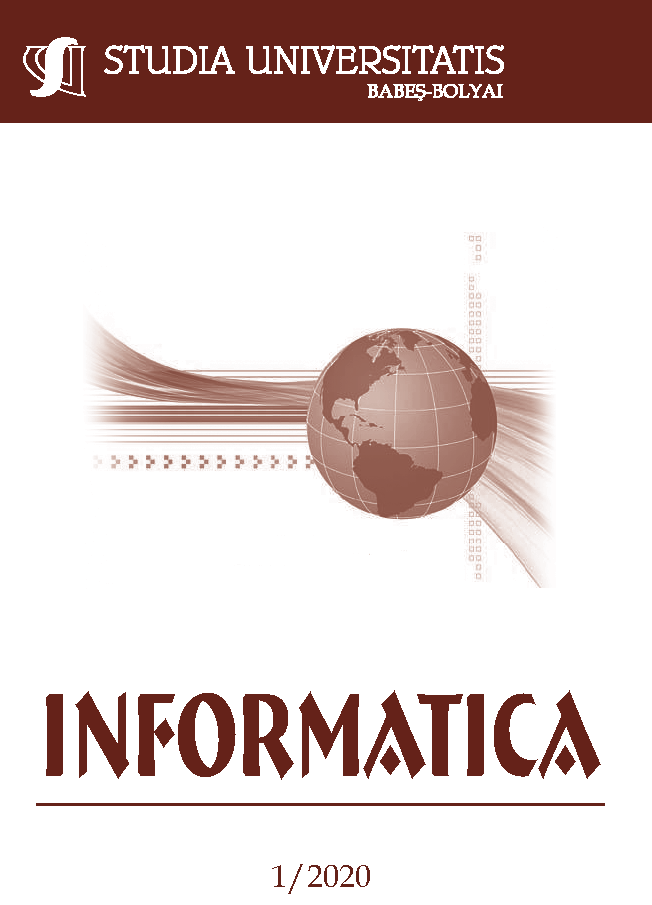GENERALIZED CELLULAR AUTOMATA FOR EDGE DETECTION
DOI:
https://doi.org/10.24193/subbi.2020.1.06Keywords:
Cellular Automata, Genetic Algorithm, Edge Detection, Curriculum Learning, Optimization.Abstract
Cellular Automata (CA) are simple, easily parallelizable models that have been used extensively for various computational tasks. Such models are especially useful for image processing, as mapping automaton cells to image pixels is straightforward and intuitive. This paper proposes a novel optimization framework for CA rules based on evolutionary algorithms and used in edge detection. This approach addresses the problem of optimizing an individual CA rule for one image and extends it to the optimization of a generic CA rule for a set of similar images. In order to maximize the transferability of the optimized rule, the algorithm is trained on sets of images using a curriculum learning approach. A study of the supervised fitness function as well as batch optimization experiments show that the algorithm is robust and competitive with the state-of-the-art methods.
References
Canny, J. A computational approach to edge detection. IEEE Transactions on pattern analysis and machine intelligence, 6 (1986), 679–698.
Caruana, R. A., and Schaffer, J. D. Representation and hidden bias: Gray vs. binary coding for genetic algorithms. In Machine Learning Proceedings 1988. Elsevier, 1988, pp. 153–161.
Christiyana, C. C., Rajamani, V., and Devi, A. U. Ultra sound kidney image retrieval using time efficient one dimensional glcm texture feature. IJCA Special Issue on Advanced Computing and Communication Technologies for HPC Applications, 4 (2012), 12–17.
Dice, L. R. Measures of the amount of ecologic association between species. Ecology 26, 3 (1945), 297–302.
Diwakar, M., Patel, P. K., and Gupta, K. Cellular automata based edge-detection for brain tumor. In 2013 International Conference on Advances in Computing, Communications and Informatics (ICACCI) (2013), IEEE, pp. 53–59.
Elman, J. L. Learning and development in neural networks: The importance of starting small. Cognition 48, 1 (1993), 71–99.
Enescu, A., Andreica, A., and Diosan, L. Evolved cellular automata for edge detection in grayscale images. In 2019 21st International Symposium on Symbolic and Numeric Algorithms for Scientific Computing (SYNASC) (2019), IEEE, pp. 326–332.
Farbod, M., Akbarizadeh, G., Kosarian, A., and Rangzan, K. Optimized fuzzy cellular automata for synthetic aperture radar image edge detection. Journal of Electronic Imaging 27, 1 (2018), 013030.
Frank, G. Pulse code communication, Mar. 17 1953. US Patent 2,632,058.
Hacohen, G., and Weinshall, D. On the power of curriculum learning in training deep networks. arXiv preprint arXiv:1904.03626 (2019).
Jain, R., Kasturi, R., and Schunck, B. G. Edge detection. In Machine vision (1995), vol. 5, McGraw-Hill New York, pp. 140–185.
Martin, D., Fowlkes, C., Tal, D., and Malik, J. A database of human segmented natural images and its application to evaluating segmentation algorithms and measuring ecological statistics. In Computer Vision, 2001. ICCV 2001. Proceedings. Eighth IEEE International Conference on (2001), vol. 2, IEEE, pp. 416–423.
Mofrad, M. H., Sadeghi, S., Rezvanian, A., and Meybodi, M. R. Cellular edge detection: Combining cellular automata and cellular learning automata. AEU-International Journal of Electronics and Communications 69, 9 (2015), 1282–1290.
Mohammed, J., and Nayak, D. R. An efficient edge detection technique by two dimensional rectangular cellular automata. CoRR abs/1312.6370 (2013).
Nayak, D. R., Patra, P. K., and Mahapatra, A. A survey on two dimensional cellular automata and its application in image processing. IJCA Proceedings on International Conference on Emergent Trends in Computing and Communication (ETCC-2014) ETCC, 1 (2014), 78–87.
Neumann, J., Burks, A. W., et al. Theory of self-reproducing automata, vol. 1102024. University of Illinois press Urbana, 1966.
Poobathy, D., and Chezian, R. M. Edge detection operators: Peak signal to noise ratio based comparison. International Journal of Image, Graphics and signal processing 6, 10 (2014), 55.
Qadir, F., Peer, M. A., and Khan, K. A. Efficient edge detection methods for diagnosis of lung cancer based on two dimensional cellular automata. Advances in Applied Science Research 4, 3 (2012), 2050–2058.
Rue, H. Baddeley’s delta metric. In Banks (eds), Encyclopedia of Statistical Sciences, Vol. Update Volume (1996), Citeseer.
Schaffer, J. A study of control parameters affecting online performance of genetic algorithms for function optimization. San Meteo, California (1989).
Sinaie, S., Ghanizadeh, A., Majd, E. M., and Shamsuddin, S. M. A hybrid edge detection method based on fuzzy set theory and cellular learning automata. In 2009 International Conference on Computational Science and Its Applications (2009), IEEE, pp. 208–214.
Sobel, I., and Feldman, G. A 3x3 isotropic gradient operator for image processing. a talk at the Stanford Artificial Project in (1968), 271–272.
Sørensen, T. A Method of Establishing Groups of Equal Amplitude in Plant Sociology Based on Similarity of Species Content and Its Application to Analyses of the Vegetation on Danish Commons. Biologiske skrifter. I kommission hos E. Munksgaard, 1948.
Tizhoosh, H. R. Fast fuzzy edge detection. In 2002 Annual Meeting of the North American Fuzzy Information Processing Society Proceedings. NAFIPS-FLINT 2002 (Cat. No. 02TH8622) (2002), IEEE, pp. 239–242.
Tizhoosh, H. R., Haußecker, H., Ja¨hne, B., Haußecker, H., and Geißler, P. Fuzzy image processing: an overview. Handbook on computer vision and applications, Academic Press, Boston (1998).
Uguz, S., Sahin, U., and Sahin, F. Edge detection with fuzzy cellular automata transition function optimized by pso. Computers & Electrical Engineering 43 (2015), 180–192.
Downloads
Published
How to Cite
Issue
Section
License
Copyright (c) 2020 Studia Universitatis Babeș-Bolyai Informatica

This work is licensed under a Creative Commons Attribution-NonCommercial-NoDerivatives 4.0 International License.





